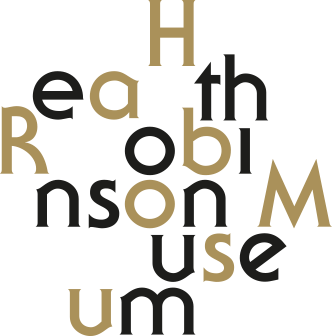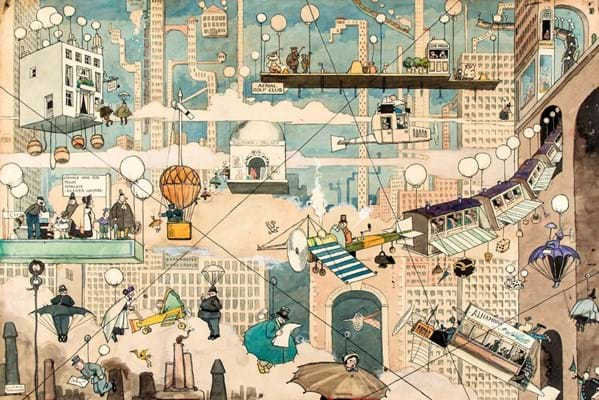19th of September 2020, by Judith Spunache
On the 19th of September, Heath Robinson Museum took part in the Open House event, as part of an annual festival when people are invited to visit buildings of London with architectural significance. The proposed free tours aim at promoting an accessible and open city. In this regard, the Heath Robinson museum took the opportunity to celebrate its architecture that complements its local urban surroundings.
It was a glorious day towards the end of the summer, before the pitter-patter of autumn rain. A large sun was resting upon Pinner Memorial Park. In front of the museum, near the birdcage, a little boy in a cheerfully patterned overall is sitting on the concrete, chalk stick in hand, drawing on the ground. Claire Linge’s activity, “Draw on the Museum”, brings together children to reclaim the land by means of art. Children’s drawings fill the ground and the walls of paper arranged around the building. Cars, flowers, hearts, cats and other mysterious creatures; a dad draws the contours of a face, while his child adds the eyes, nose and mouth.
White tables and chairs lay under a tree. There is green grass and a pond. Families are resting on the ground; kids are running around. The eternal attempt to catch a duck is underway. The peaceful encounter of generations is a heart-warming sight compared to the recollection of recent isolation; what a fantastic view to contemplate through the magnificent windows of the museum.
Through the angles of the windows, the brightness of the day invades the indoor space, unifying the museum with the park. From the inside, the life scene taking place around the pond becomes a painting, a living illustration of Naïve art[i] in its purest style. This is the greatest achievement of the building’s architecture. The architect company, ZMMA, had a vision to harmonize the structure of the building with the art it displays, as well as the guests from the park. With extreme delicacy, the project director, Adam Zombory-Moldova, made his design serve Heath Robinson’s art displays and locality more than anything. This achievement owes a lot to his strong view regarding museums as a public space. He declared them “life enhancing, where people can share space with objects of value and wonder” and “a place and reason for people to gather”[ii].
Light was a key material for construction of the museum. When you enter, note the disparate light bulbs of different size, material and height. The dominating colours are soft, made of white and naked wood, creating an atmosphere comparable to a Nordic sauna of light cedar essence—a proper place to breath and pause from urban turbulence. The building hosting the museum looks simple from the outside, but when you enter, you discover a multi-sided space and you feel like you are in an intricate Rubik’s cube. Lift up your eyes and stare at the ceiling, the latticed timber structure forming a net of geometrical shapes, the aluminium air ducts and the impression of second dimension given by the slope of the roof.
As I was talking to a visitor who came to the Open House event for the first time, I realised this building structure echoes Heath Robinson’s work, his crazy contraptions, and the infinite creativity of an ever-curious mind. The mechanical inventions of Heath Robinson have a wonderful power of attraction which are almost hypnotic. To the architect and Professor CJ Lim, Heath Robinson is “still very current in his mode of inventiveness, particularly in the age of computers”[iii].
During the Open House event, multiple facets of Heath Robinson’s work were noticeable from the visitors’ discourse. A lovely lady, who came by recommendation of her son, enjoyed the best of the illustrator’s humour and the sharpness of his drawing e.g. Folding Garden and Sports Without Broad Acres. She was also surprised to discover the ties the artist had with Pinner, a not so well-known fact. I told her that he had lived for ten years in Pinner.
Another visitor was standing in complete fascination, facing one of the Heath Robinson’s fairy pieces, where a frail light evaporates into the nature beyond. One of the volunteers with whom I had a very agreeable conversation said she did not realise the width of Heath Robinson’s imagination and the romantic touch in his works before getting involved at the museum.
Heath Robinson’s work makes day-to-day life challenges become a joyful discovery and brings out their eccentricity. He was an artist who managed to reach the climax of pragmatism, yet also developed a mischievous from of art where his inventions become poetry. Maybe that is what makes the Heath Robinson museum so special—the combination of the object (the museum’s structure) with the subject (Heath Robinson). After all, this building is the perfect host for the timeless art it holds.
[i] Naïve Art is mainly characterized by simplicity, the mastering of colours and the less importance given to perspective (Louise Braithwaite is a contemporaneous example of this style). [ii] “On the museum trail”, Isabelle Priest, The RIBA Journal, 5 December 2016 : https://www.ribaj.com/culture/on-the-museum-trail [iii] “William Heath Robinson museum finally opens this weekend. Who is the man behind the legend?”, Olivia Solon, The Wired, Thursday 13 October 2016 : https://www.wired.co.uk/article/heath-robinson-deserves-a-museum

